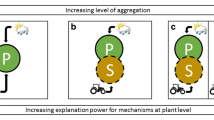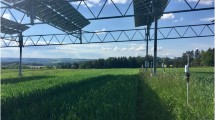Abstract
This study estimated the construction const (CC) and maintenance cost (MC) of leaf tissue on the basis of dry mass (CCMass, MCMass) and leaf area (CCArea, MCArea), as well as the maximum leaf gas exchange capacity, so as to examine leaf cost:benefit relationship in six dominant species of the ‘Bana’ vegetation. Minimum and maximum CCMass averaged 1.71 ± 0.03 and 1.78 ± 0.03 g glucose g−1. The CCMass showed a statistically significant positive correlation with crude fibre, and tended to decline as leaves were larger. Thus, smaller leaves tended to be built out of a more expensive material than that found in species bearing larger leaves. The average CCArea of the ‘Bana’ species was 376 ± 15 g glucose m−2. A robust correlation was found between CCArea with leaf dry mass to leaf area ratio, as well as with leaf thickness, but not with leaf density. MCMass (g glucose g−1 day−1) and MCArea (g glucose m−2 day−1) were positively correlated. Maximum and minimum MCMass increased significantly with protein and lipid content, respectively. Maximum carbon assimilation (A max) was positively correlated with CCArea. All the species operated at high stomatal conductance (g s) and C i/C a which suggested low short-term water use efficiency. Potential nitrogen use efficiency (PNUE = A max/N) averaged 35.4 ± 1.8 mmol CO2 mol−1 N. As the sclerophylly index (g crude fibre g−1 protein) increased, the ratio of CCArea to A max increased significantly. This result suggests a trade-off between investments in an expensive resistant sclerophyllous leaf which should maximize carbon gain in the long term.





Similar content being viewed by others
References
Attiwill JM, Adams MA (1993) Tansley Review 50. Nutrient cycling in forest. New Phytol 124:561–582. doi:10.1111/j.1469-8137.1993.tb03847.x
Bloom AJ, Chapin FSIII, Mooney HA (1985) Resource limitation in plants: an economics analogy. Annu Rev Ecol Syst 16:363–392
Bongers F, Engelen D, Klinge H (1985) Phytomass structure of natural plant communities on spodosol in southern Venezuela: the Bana woodland. Vegetatio 63:13–94. doi:10.1007/BF00032183
Chabot BF, Hicks DJ (1982) The ecology of leaf life span. Annu Rev Ecol Syst 13:229–259. doi:10.1146/annurev.es.13.110182.001305
Chapin FSIII (1989) The cost of tundra plant structures: evaluation of concepts and currencies. Am Nat 113:1–19
Choong MF, Lucas PW, Ong JSY, Pereira B, Tan HTW, Turner IM (1992) Leaf fracture toughness and sclerophylly: their correlations and ecological implications. New Phytol 121:597–610. doi:10.1111/j.1469-8137.1992.tb01131.x
Coley PD (1983) Herbivory and defensive characteristics of tree species in a lowland tropical rain forest. Ecol Monogr 53:209–233. doi:10.2307/1942495
Eamus D, Prichard H (1998) A cost-benefit analysis of leaves of four Australian species. Tree Physiol 18:537–545
Eamus D, Myers B, Duff G, Williams (1999) A cost-benefit analysis of leaves of eight Australian savanna tree species of difffering leaf life-span. Photosynthetica 36:575–586
Field C, Mooney HA (1986) The photosynthesis-nitrogen relationship in wild plants. In: Givnish T (ed) On the economy of plant form and function. Cambridge University Press, London, pp 25–55
Givnish TJ (1986) Economics of gas exchange. In: Givnish T (ed) On the economy of plant form and function. Cambridge University Press, London, pp 11–24
Griffin KL (1994) Calorimetric estimates of construction cost and their use in ecological studies. Funct Ecol 8:851–862. doi:10.2307/2389915
Grubb PJ (1986) Sclerophylls, pachyphylls and pycnophylls: the nature and significance of hard leaf surface. In: Juniper BE, Southwood TRE (eds) Insects and the plant. Edward Arnold, London, pp 137–150
Herms DA, Matson WJ (1992) The dilemma of plants: to grow or defend. Q Rev Biol 67:283–335. doi:10.1086/417659
Herrera R, Jordan CF, Klinge H, Medina E (1978) Amazon ecosystems. Their structure and functioning with particular emphasis on nutrients. Interciencia 3:223–232
Kikuzawa K (1991) A cost-benefit analysis of leaf habit and leaf longevity of trees and their geographical pattern. Am Nat 138:1250–1263. doi:10.1086/285281
Lichtenthaler HK, Wellburn AR (1983) Determinations of total carotenoids and chlorophylls a and b of leaf extracts in different solvents. Biochem Soc Trans 603:591–592
Loveless AR (1961) A nutritional interpretation of sclerophylly based on differences in the chemical composition of sclerophyllous and mesophytic leaves. Ann Bot (Lond) 25:168–184
Loveless AR (1962) Further evidence to support a nutritional interpretation of sclerophylly. Ann Bot (Lond) 26:551–561
Medina E, Garcia V, Cuevas E (1990) Sclerophylly and oligotrophic environments: relationships between leaf structure and mineral nutrient content, and drought resistance in tropical rain forests the upper Rio Negro region. Biotropica 22:51–54. doi:10.2307/2388719
Merino JA, Field CB, Mooney HA (1982) Construction and maintenance costs of mediterranean-climate evergreen and deciduous leaves I. Growth and CO2 exchange analysis. Oecologia 52:2008–2213
Merino J, Field C, Mooney HA (1984) Construction and maintenance costs of Mediterranean-climate evergreen and deciduous leaves. Acta Oecol Plant 5:211–229
Müller-Dombois D, Ellemberg H (1974) Aims and methods of vegetation ecology. Willey, New York
Navas ML, Ducout B, Roumet C, Richarte J, Garnier J, Garnier E (2003) Leaf life span, dynamics and construction cost of species from Mediterranean old-fields differing in successional status. New Phytol 159:213–228. doi:10.1046/j.1469-8137.2003.00790.x
Niinemets U (1999) Components of leaf dry mass per area-thickness and density- alter leaf photosynthetic capacity in reverse directions in woody plants. New Phytol 144:35–47. doi:10.1046/j.1469-8137.1999.00466.x
Oikawa S, Hikosaka K, Horse T, Shiyomi M, Takahashi S, Hori Y (2004) Cost-benefit relationship in fronds emerging at different times in a deciduous fern, Pteridium aquilum. Can J Bot 82:521–527. doi:10.1139/b04-026
Penning de Vries FWT, Brunsting AHM, can Laar HH (1974) Products, requirements and efficiency of biosynthesis: a quantitative approach. J Theor Biol 45:339–377. doi:10.1016/0022-5193(74)90119-2
Poorter H (1994) Construction costs and payback time of biomass: a whole plant perspective. In: Roy J, Garnier E (eds) A whole plant perspective on carbon–nitrogen interactions. SPB Academic Publishers, The Hague, pp 111–127
Poorter H, DeJong R (1999) A comparison of specific leaf area, chemical composition and leaf construction cost of field plants from 15 habitats differing in productivity. New Phytol 143:163–176. doi:10.1046/j.1469-8137.1999.00428.x
Poorter H, Villar R (1977) The fate of acquired carbon in plants: chemical composition and construction costs. In: Bazzas FA, Grace J (eds) Resources allocations in plants. Academic Press, San Diego, pp 39–72
Read J, Stokes A (2006) Plant biomechanics in an ecological context. Am J Bot 93:1546–1565. doi:10.3732/ajb.93.10.1546
Read J, Sana GD, Garine-Wichatitsky M, Jafree T (2006) Sclerophylly in two contrasting tropical environments: low nutrient vs. low rainfall. Am J Bot 93:1601–1614. doi:10.3732/ajb.93.11.1601
Reich PB, Walters MB, Ellsworth DS, Uhl C (1994) Photosynthesis-nitrogen relations in Amazonian tree species. I. Patterns among species and communities. Oecologia 97:62–72. doi:10.1007/BF00317909
Reich PB, Ellsworth DS, Walters MB et al (1999) Generality of leaf trait relationships: a test across six biomes. Ecology 80:1955–1969
Sobrado MA (1977) Aspectos ecofisiológicos de la vegetación esclerófila de suelos arenosos, podzolizados e inundables de la cuenca del Río Negro, Territorio Federal Amazonas. Tesis de Biología. Facultad de Ciencias, Universidad Central de Venezuela, Caracas
Sobrado MA (1991) Cost-benefit relationships in deciduous and evergreen leaves of tropical dry forest species. Funct Ecol 5:608–616. doi:10.2307/2389479
Sobrado MA (1994) Leaf age effects on photosynthetic rate, transpiration rate and nitrogen content in a tropical dry forest. Physiol Plant 90:210–215. doi:10.1111/j.1399-3054.1994.tb02213.x
Sobrado MA (1995) The influence of leaf age and drought on photosynthesis of the tropical evergreen tree Curatella americana L. In: Mathis P (ed) Photosynthesis from light to biosphere, vol IV. Kluwer, Dordrecht, pp 549–552
Sobrado MA (2008) Leaf characteristics and diurnal variation of chlorophyll fluorescence in leaves of the ‘Bana’ vegetation of the Amazon region. Photosynthetica 46:202–207. doi:10.1007/s11099-008-0033-9
Sobrado MA, Medina (1980) General morphology, anatomical structure and nutrient content of sclerophyllous leaves of the ‘Bana’ vegetation. Oecologia 45:341–345. doi:10.1007/BF00540202
Suarez N (2003) Leaf longevity, construction, and maintenance costs of three mangrove species under field conditions. Photosynthetica 41:373–381. doi:10.1023/B:PHOT.0000015461.36848.c5
Suarez N (2005) Leaf construction cost in Avicennia germinans as affected by salinity under field conditions. Biol Plant 49:111–116. doi:10.1007/s10535-005-1116-0
Turner IM (1994a) A quantitative analysis of leaf form in woody plants from the world’s major broad-leaved forest types. J Biogeogr 21:413–419. doi:10.2307/2845759
Turner IM (1994b) Sclerophylly: primarily protective? Funct Ecol 8:669–675. doi:10.2307/2390225
Villar R, Merino J (2001) Comparison of leaf construction costs in woody species with differing leaf life-spans in contrasting ecosystems. New Phytol 151:213–226. doi:10.1046/j.1469-8137.2001.00147.x
Villar R, Ruiz-Robleto J, DeYong Y, Poorter H (2006) Differences in contruction costs and chemical composition between deciduous and evergreen woody species are small as compared to differences among families. Plant Cell Environ 29:1629–1643. doi:10.1111/j.1365-3040.2006.01540.x
Vitousek PM, Gosz JR, Grier CC, Reiner WA (1982) A comparative analysis of potential nitrification and nitrate mobility in forest ecosystems. Ecol Monogr 52:155–177. doi:10.2307/1942609
Wallace AR (1889) A narrative of travel of the Amazon and Rio Negro. Dover Publications, Inc., New York, pp 160–161
William S (1984) Official methods of analysis. AOC, Arlington
Williams K, Percival F, Merino J, Mooney HA (1987) Estimation of tissue construction costs from heat of combustion and organic nitrogen content. Plant Cell Environ 10:725–734
Williams K, Field CB, Mooney HA (1989) Relationships among leaf construction cost, leaf longevity, and light environment in a rain-forest plant of the genus Piper. Am Nat 133:198–211. doi:10.1086/284910
Witkowski ETF, Lamont BB (1991) Leaf specific mass confounds leaf density and thickness. Oecologia 88:486–493
Acknowledgments
Financial support was provided by ‘Fundación Empresas Polar’ and DID-USB (‘Fondo de Trabajo 2008’). Logistic support for the field work in San Carlos de Rio Negro was received from Pedro and Olga Maquirino, Euclides and Mirla Da Silva, and Mariano and Eliana Silva. I am pleased to thank Editors and anonymous referees for all the help, encouragement and suggestions for the publication of this manuscript.
Author information
Authors and Affiliations
Corresponding author
Additional information
Communicated by M. Adams.
Rights and permissions
About this article
Cite this article
Sobrado, M.A. Cost-benefit relationships in sclerophyllous leaves of the ‘Bana’ vegetation in the Amazon region. Trees 23, 429–437 (2009). https://doi.org/10.1007/s00468-008-0292-x
Received:
Revised:
Accepted:
Published:
Issue Date:
DOI: https://doi.org/10.1007/s00468-008-0292-x




